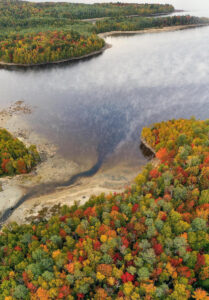Dead River Rafting Part 1: Creation of Maine’s Largest Man-made Lake
 Dead River rafting would not exist without the creation of Maine’s largest man-made lake – Flagstaff Lake. In the fall of 1949, the Dead River was diverted, and as a consequence, the towns of Flagstaff and Dead River were flooded. The State of Maine believed that the flooding of the towns was critical for two reasons: to help meet the increasing demand of the state’s electrical power needs and as a measure to maintain flood control of the lower Kennebec River.
Dead River rafting would not exist without the creation of Maine’s largest man-made lake – Flagstaff Lake. In the fall of 1949, the Dead River was diverted, and as a consequence, the towns of Flagstaff and Dead River were flooded. The State of Maine believed that the flooding of the towns was critical for two reasons: to help meet the increasing demand of the state’s electrical power needs and as a measure to maintain flood control of the lower Kennebec River.
For many folks, Flagstaff Lake is a sign of progress and viewed as the place where the old Maine and the new Maine came together. The Dead River Area Historical Society maintains a memorial room, which shares the lineage and artifacts of several native families, to honor the lost towns of Flagstaff and Dead River. At the time of flooding, residents of the two towns were forced to relocate so the lake could be made by the newly constructed dam. Many homes, barns and community buildings can still be found deep within the lake.
The Long Falls Dam, where water is now released for us to enjoy Dead River rafting, impounds the waters of Flagstaff Lake. The Dead River Area Historical Society and the towns of Eustis and Stratton encourage visitors to experience the wonders of Flagstaff Lake and the stories of the valley below.
Want to know more about the history of the Dead River? This is a three part blog so be sure to read Dead River Rafting Part 2 and Dead River Rafting Part 3, coming up in subsequent posts.
Dead River Area Historical Society
Northern Outdoors

